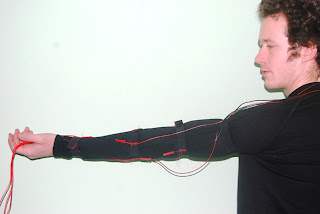However, the rigid plastic parts required for the pressure fitting do not especially appeal to me, they are clumsy and don’t work as well as I was hoping they would.
I was hoping to find a method of making the actual sensor more stable and making it easier to attach the sensor to clothing. I ended up sewing the sensor and cable directly to elastic bands. This works fairly well, especially as the maximum stretch of the elastic is less than that of the sensor, protecting the sensor from being overstretched. Well … enough talk, take a look at the pictures to see how this looks in practice
Ahh… and ignore all the extra threads and sloppy craftmanship. Next-time round this will look a lot prettyer. My sewing machine and me *are* (slowly) becoming friends…














